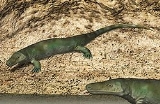
Limnoscelis
Encyclopedia
Limnoscelis is a genus
of large, very reptile-like diadectomorph
(a type of reptile-like amphibian
) from the Early Permian
of North America
. Contrary to other diadectomorphans, Limnoscelis appear to have been a carnivore. Though the post cranial skeleton is very similar to the early large bodied reptiles like pelycosaurs and pareiasaurs
, the digits lacked claws, and the bones of the ankle bones were fused like in other reptile-like amphibians. This would not allow them to use their feet actively in traction, but rather as holdfasts, indicating Limnoscelis primarily hunted slow moving prey.
Genus
In biology, a genus is a low-level taxonomic rank used in the biological classification of living and fossil organisms, which is an example of definition by genus and differentia...
of large, very reptile-like diadectomorph
Diadectomorpha
Diadectomorpha are a clade of large reptile-like amphibians that lived in Euramerica during the Carboniferous and Early Permian periods, and are very close to the ancestry of the Amniota. They include both large carnivorous and even larger herbivorous forms, some semi-aquatic and others fully...
(a type of reptile-like amphibian
Reptiliomorpha
Reptiliomorpha refers to an order or subclass of reptile-like amphibians, which gave rise to the amniotes in the Carboniferous. Under phylogenetic nomenclature, the Reptiliomorpha includes their amniote descendants though, even in phylogenetic nomenclature, the name is mostly used when referring to...
) from the Early Permian
Permian
The PermianThe term "Permian" was introduced into geology in 1841 by Sir Sir R. I. Murchison, president of the Geological Society of London, who identified typical strata in extensive Russian explorations undertaken with Edouard de Verneuil; Murchison asserted in 1841 that he named his "Permian...
of North America
North America
North America is a continent wholly within the Northern Hemisphere and almost wholly within the Western Hemisphere. It is also considered a northern subcontinent of the Americas...
. Contrary to other diadectomorphans, Limnoscelis appear to have been a carnivore. Though the post cranial skeleton is very similar to the early large bodied reptiles like pelycosaurs and pareiasaurs
Pareiasaur
The Pareiasaurs - Family Pareiasauridae - are a clade of medium-sized to large herbivorous anapsid reptiles that flourished during the Permian period....
, the digits lacked claws, and the bones of the ankle bones were fused like in other reptile-like amphibians. This would not allow them to use their feet actively in traction, but rather as holdfasts, indicating Limnoscelis primarily hunted slow moving prey.

